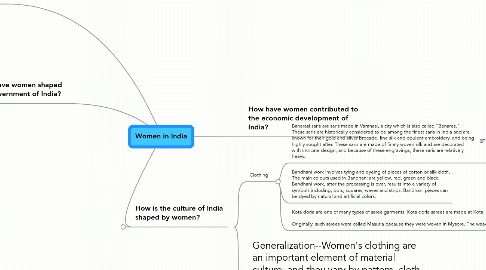
1. How have women shaped the government of India?
1.1. On one hand, India falls in the lowest quartile with respect to the number of women in parliment (9.1%,14th loksabha).
1.2. The Gond queen Durgavati ruled for fifteen years, before she lost her life in a battle with Mughal emperor Akbar's general Asaf Khan in 1564.
1.3. In ancient India, the women in India faced confinement and restrictions
1.4. The Government of India declared 2001 as the Year of Women's Empowerment (Swashakti). The National Policy For The Empowerment Of Women came was passed in 2001.
1.5. Indira Gandhi, who served as Prime Minister of India for an aggregate period of fifteen years is the world's longest serving woman Prime Minister.
2. Generalization 1: While women continue to struggle to be part of India's government, a number of women have been very successful: Razia Sultana, Gond Queen Durgavati and Indira Gandhi.
3. How is the culture of India shaped by women?
3.1. Clothing
3.1.1. Banarasi saris are saris made in Varanasi, a city which is also called "Benares." These saris are historically considered to be among the finest saris in India and are known for their gold and silver brocade, fine silk and opulent embroidery, and being highly sought after. These saris are made of finely woven silk and are decorated with intricate design, and because of these engravings, these saris are relatively heavy.
3.1.2. Bandhani work involves tying and dyeing of pieces of cotton or silk cloth, The main colours used in Bandhani are yellow, red, green and black. Bandhani work, after the processing is over, results into a variety of symbols including, dots, squares, waves and strips. Bandhani pieces can be dyed by natural and artificial colors.
3.1.3. Kota doria are one of many types of saree garments. Kota doria sarees are made at Kota, Rajasthan and Muhammadabad Gohna, Mau Utterpradesh city and its nearby area. Sarees are made of pure cotton and silk and have square like patterns known as khats on them. Originally, such sarees were called Masuria because they were woven in Mysore. The weavers were subsequently brought to Kota by Rao Kishore Singh who was a general in the Mughal army.
